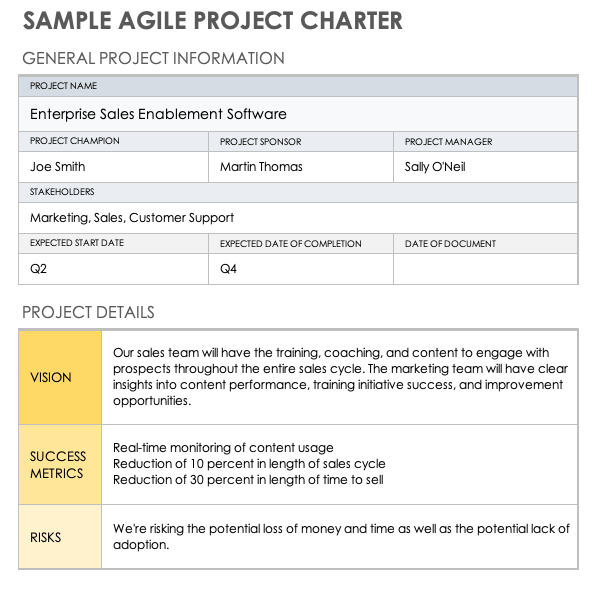Do Agile Projects Have Project Charters?
A project charter is a document that gives project managers the authority to act on behalf of a project. Project charters are necessary for ensuring the successful completion of all objectives, which is essential for any project, including Agile projects.
"The project charter is the most important document for the entire project,,” shares Mary Beth Imbarrato, PMP, CSM, SPP, CMS, Owner of MBI Consulting. “In more than 25 years of working in project management, I have been asked numerous times to help fix projects that have gone off the rails. The one common denominator? No project charter.”
What Is an Agile Project Charter?
”An Agile project charter is a living, updateable document that serves as a roadmap through the Agile process. It outlines a project’s scope, objectives, and deliverables, ensuring that everyone is working toward a common purpose.
“Agile projects leverage the Lean startup model to develop and test a hypothesis and then stop, pivot, or persevere,” explains Alan Zucker, Founding Principal of Project Management Essentials. “Projects stop if the team realizes this is not a viable product or there is not a market for it. We should cut our losses and move on. We pivot when we find a nugget worth pursuing, but it requires changing direction. We persevere when the hypothesis is validated.”
Teams that follow a well-designed project charter will remain focused on a common goal, which makes it easier to identify when that goal needs to be adjusted or replaced. “Pivoting is valuable,” Zucker continues. “We have found something valuable but need to apply it differently. There are many great examples of pivots, including Slack, which started as a gaming community, and YouTube, which started as a dating site.”
Creating a successful project charter begins with a collaborative project kickoff meeting, where team members can align their goals, assign responsibilities, and design a comprehensive plan for project completion. Input from all stakeholders is essential for drafting a thorough and effective project charter.
Below are the essential team members who contribute to the creation and execution of an Agile project charter:
- Scrum Master: Sometimes called the project facilitator, the Scrum master is a critical team member who supports the team by organizing resources, limiting pressure from stakeholders, and removing barriers that might disrupt the team's workflow. The Scrum master works at a high level, incorporating feedback from different team members and stakeholders to develop a clear and comprehensive mission or vision for the project.
- Cross-Functional Team Members: These team members will complete the actual work involved in producing deliverables for the client, so their input is necessary in determining individual objectives and feasibility. Cross-functional team members will also use the charter to stay focused on the main motivations behind a project.
- Product Owner: The product owner is responsible for ensuring that projects successfully meet the specific needs of clients or users by managing project activity, minimizing waste, and delivering a quality product. After incorporating stakeholder, team, and management feedback into the project charter, the product owner continues to seek feedback and updates the project charter as the project progresses.
- Stakeholders: In an Agile project, stakeholders include project funders, business department leaders, users, and other team members who directly or indirectly benefit from the project. A charter is a consulting tool that requires stakeholder input both initially and as the project continues to develop and progress.
“Since an Agile project is defined as a project using an Agile methodology,” says Imbarrato, “it should not impact the overall objective, strategic goal alignment, risks, and assumptions identified for the project. A project charter should be used for all projects regardless of the methodology. The project charter is the first piece of the communication plan. It allows the organization, stakeholders, and project team to understand the project's objective and some of the high-level elements.
Benefits of Writing an Agile Project Charter
Creating an Agile project charter ensures that all team members understand the objectives, output, timeline, and budget of a project. By using an Agile project charter, project managers can more easily identify and mitigate risks and track progress against goals.
"If done well, a project charter communicates the fundamentals, thus increasing the reliability of communication,” shares Dave West, Product Owner and CEO of Scrum.org, “but perhaps the biggest benefit of a charter is its creation. The discussions it drives can provide amazing clarity for the team and key stakeholders. A project charter underlies the saying that there is value in the journey, not the destination."
Additional benefits that result from writing an Agile project charter including the following:
- Improves Communication and Collaboration: By using a project charter, project managers can ensure that all team members are aware of the project's goals and there are no unwanted surprises during project execution.
- Encourages Team Alignment: When teams agree on project objectives from the outset, everyone can stay focused on critical tasks and avoid costly distractions.
- Improves Project Transparency: If project goals are clearly defined and communicated from the outside, stakeholders, team members, and project managers will be better able to see and understand achievements and progress.
- Prevents Scope Creep: By clearly defining and documenting project objectives early on in a project charter, project managers can prevent scope creep, which happens when the scope of a project is redefined or expanded after project initiation. This can potentially lead to missed deadlines, budgetary problems, and other costly complications.
- Aligns with Traceability Matrix: The project charter includes the overall vision of the project. This aligns directly with the project traceability matrix to ensure the team delivers the agreed-upon results.
"One participant in my class told us that she went back to her office after day one of the course and completed project charters for all of her projects,” shares Imbarrato. “She then hung a copy of the project charters outside her cubicle wall. She also posted a copy of the project charter for a high-priority project by the coffee machine in the cafe. I loved it! What a great idea. She wanted to make sure that everyone understood the projects that were underway. She nailed it, and her colleagues enjoyed reading about her projects — win-win."
What to Include in an Agile Project Charter
An Agile project charter includes potential risks, success criteria, specific responsibilities, and other details associated with a project. Each component of the charter should help communicate the vision of a project and guide team members through successful project execution.
These are the central components of an Agile project charter:
- Mission or Vision: Clarify why the project exists, what business outcome it is trying to achieve, and which stakeholders will be affected. Define what success looks like for the project by using metrics, targets, or other performance indicators to help track project progress objectively.
- Risks: Document any uncertainties that could affect the project, and outline your team's mitigation plan. Risk management planning is essential for coping with obstacles such as budget cuts and personnel changes, and they should be included on every Agile project charter.
- Responsibilities: Outline the key roles and responsibilities, and assign them to teams or individuals. Include both technical and non-technical positions and people who will be responsible for communicating with stakeholders.
- Stakeholders: Make a list of everyone who will impact or be impacted by the project. This list should include individuals or groups who will need to provide input or sign off on the project and those who will be held accountable for results.
- Success Criteria: Identify key markers of project success. Consider using a set of specific deliverables or objectives, a timeline, or other acceptance criteria to determine whether the project is on track.
In projects that use traditional Waterfall methodology, Zucker explains, “The charter is a critical foundational document. It outlines the business problem, high-level direction, requirements, timeline, budget, key stakeholders, initial risks, assumptions, constraints, etc. There is common agreement about the charter elements.
“Agile projects should have documents that describe goals, objectives, and acceptance criteria for the project,” he continues, “but there is not a consensus on what that document should be called or the included elements. There is agreement that the document should be lightweight. In other words, it should fit on a single sheet of paper, either a flip-chart sheet or an A3 sheet. ”
Both Agile and Waterfall include project charters as part of the project planning process. The project outcomes should be clear regardless of the project type. Agile and Waterfall methodologies may differ in how the work gets done, but according to Imbarrato, “There should not be a reason for distinct project charters based on methodology. All projects have objectives, assumptions, strategic alignments, and risks.”
How to Create an Agile Project Charter
Creating an Agile project charter is a collaborative effort. Be sure to start with a kickoff meeting that includes all key players in project execution, from executive sponsors to a designated team lead, and end with an easily accessible document.
During a project kickoff meeting, project managers have an opportunity to clarify goals and responsibilities, so they can create an effective project charter. “One of the first agenda items for that meeting will be the review of the project charter initiative,” says Imbarrato. “This is a great opportunity to discuss the objective, how the team will contribute to meeting that objective, and any other information about the project's goals.”
Here are the basic steps of succession project charter creation:
- Start With a Kickoff Meeting: The project charter is a collaborative document, so it is important that the executive sponsor, product owner or service manager, project manager, and team lead are present at the kickoff meeting. Be sure to keep the meeting organized with agenda items, and prepare a business case or value proposition to present. Keep the discussion high level and ensure that everyone leaves with a solid understanding of project goals.
- Draft an Agile Charter: The charter should give a brief description of the project, the problem the project will solve, objectives, and success criteria. A list of major deliverables, key milestones, and the roles and responsibilities of all team members should also be part of the document. Choose a format for the document that will be accessible to everyone within your team. This might be a text-based file, such as Microsoft Word or Google Docs, or a presentation file, such as Microsoft PowerPoint or Google Slides.
- Acquire Approvals: After completing your project charter, submit it to the executive sponsor for approval. Be sure to get buy-in from all key stakeholders before starting work on the project.
- Publish for Accessibility: After the executive sponsor approves your charter, review it with the project team to ensure that everyone is on board and understands their roles and responsibilities. Publish the charter in a place where everyone on the team can access it easily. Agree on key milestones, and start working toward achieving project goals.
Estimating Agile Project Size
The size of an Agile project will depend largely upon its scope. Clearly define the objectives of your project, and figure out what resources and work are required. Once you have this, you can estimate the size of your project.
Traditional projects require teams to complete all deliverables within a project’s scope by a specific deadline. When teams estimate project completion time without allowing for potential delays or obstacles, they risk missing deadlines or going over budget.
“Despite best efforts, few traditional projects deliver on time and within budget,” says Zucker. “Agile takes an entirely different perspective. The product backlog is a prioritized list of what may be needed or wanted. However, the product backlog is emergent. Items may be added or removed, or their prioritization may change. There is the recognition that not everything may be delivered.
“On Agile projects, we focus more on how long we want the project to persist,” he continues. “Because we have stable, persistent teams, estimating costs is very easy. The number of people on our team is multiplied by their rates and the intended project duration. It then becomes a question of how much work can be completed within our desired time or budget box.”
Tips for Writing an Agile Project Charter
When you write an Agile project charter, concision and clarity are crucial. Outline the project's purpose, scope, objectives, timeline, and deliverables, and define the roles and responsibilities of key stakeholders. Your final charter should be a single-page, easy-to-read document.
The following are best practices for writing an Agile project charter:
- Accessibility: Make your charter easily accessible for the entire team. "By having the charter front and center on the team wiki for distributed teams or in the team room for collocated teams, everyone knows where to find the key facts,” suggests West. “It is great to remind the team or infrequent visitors of what is important."
- Clarity: Ensure that your charter is easy to understand. Simple, direct, and non-technical language is essential for keeping all team members and stakeholders informed, whether or not they are involved with the technical aspects of a project. Organize your charter with bold section titles and bulleted lists to keep it clear and easy to navigate.
- Concision: Try to keep the charter to a single page. "Single pane of glass, sheet of paper, mural board — it is impossible to define the medium upon which the charter will exist,” says West. “For distributed teams, the charter must be electronic, and even for co-located teams, it is good to have a charter visible from anywhere. Immaterial of the medium and technology, the charter must be a constrained document. For example, if we took a leaf out of the Lean world, then A3 might be a great tool for a charter. The key is that the charter must be accessible and easy to read and understand, and that tends to mean short and direct."
- Collaboration: Incorporate team input when designing your project charter. "Charters must be owned by the whole team and not created by someone else,” advises West. “Ownership is key to understanding and getting value from the charter. Stakeholders must feel some connection, but the team must work together to define the content and structure."
Ultimately, your project charter should align team members and clarify objectives and avoid creating confusion. “The value of the charter is establishing the parameters of the project and the expectations,” says Zucker. “Creating a clear set of success factors, objectives, outcomes — whatever you want to call them — allows the product owner to validate the results. A common pitfall in all projects is that expectations are not set, so the team does not know what success looks like. A good charter will provide that clarity.”
Agile Project Charter Template
Download Agile Project Charter Template — Microsoft Excel
This Agile project charter is a concise document that project managers can use to help unify their teams around a project. Use this template to draft your Agile project charter with the project vision, stakeholders, resources, risks, and success criteria.
Agile Project Charter Sample
Download Sample Agile Project Charter Template — Microsoft Excel
Use this sample Agile project charter as a guide when creating your own project charter. You will find sample data for the project vision, success criteria, risks, and stakeholders that can be edited to fit the needs of your project. For additional resources and tips, see this comprehensive list of free project charter templates and guidelines.
What Is a Team Charter in Agile?
A team charter, like a project charter, is a document used in Agile projects that outlines a team’s goals and expectations. A team charter should be designed collaboratively and includes such information as values, working arrangements, rules, and norms.
"The fundamental need that the project, team, or product charter addresses is to provide a clear, transparent description of why people are working together and what key things everyone should know,” shares West. “Charters vary in content but tend to describe the why or goal of the endeavor, any significant constraints, rules conventions, or agreements that everyone should know."
Optimize Your Agile Team Charter with Smartsheet
From simple task management and project planning to complex resource and portfolio management, Smartsheet helps you improve collaboration and increase work velocity -- empowering you to get more done.
The Smartsheet platform makes it easy to plan, capture, manage, and report on work from anywhere, helping your team be more effective and get more done. Report on key metrics and get real-time visibility into work as it happens with roll-up reports, dashboards, and automated workflows built to keep your team connected and informed.
When teams have clarity into the work getting done, there’s no telling how much more they can accomplish in the same amount of time. Try Smartsheet for free, today.





